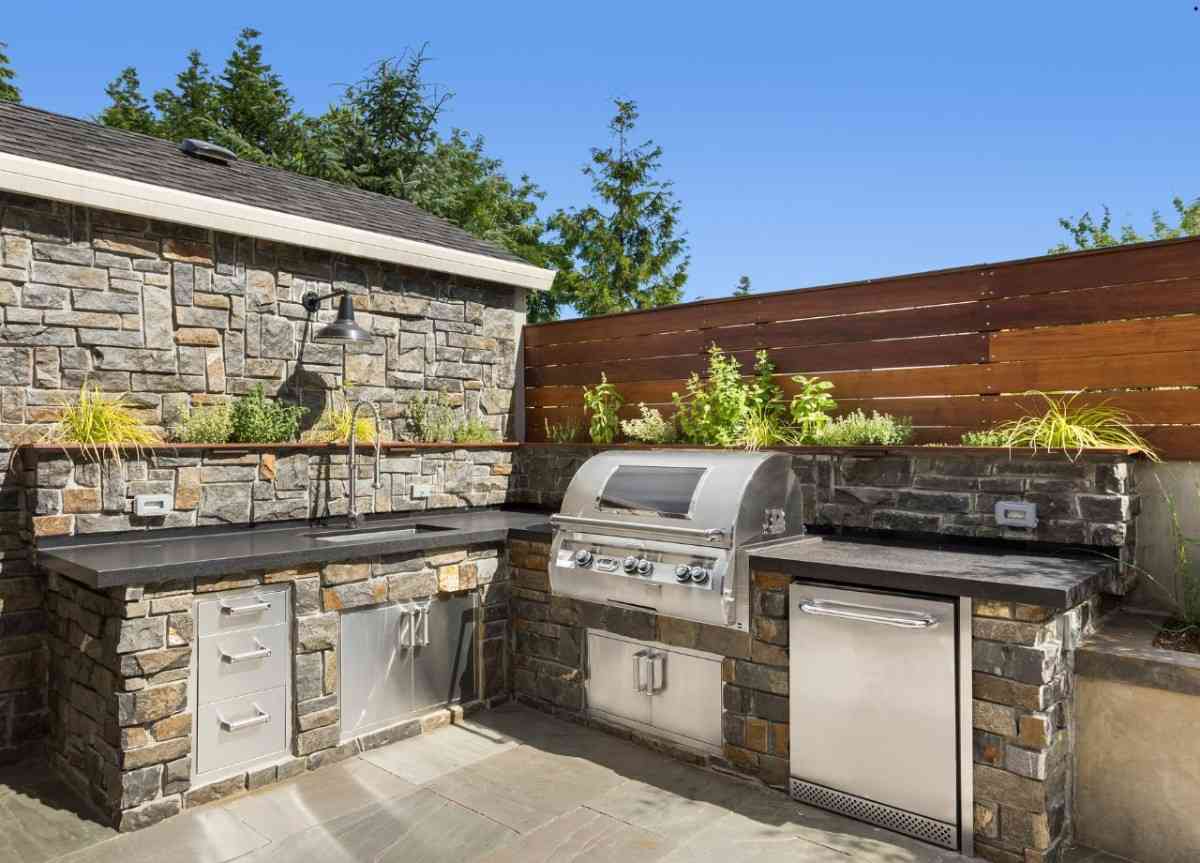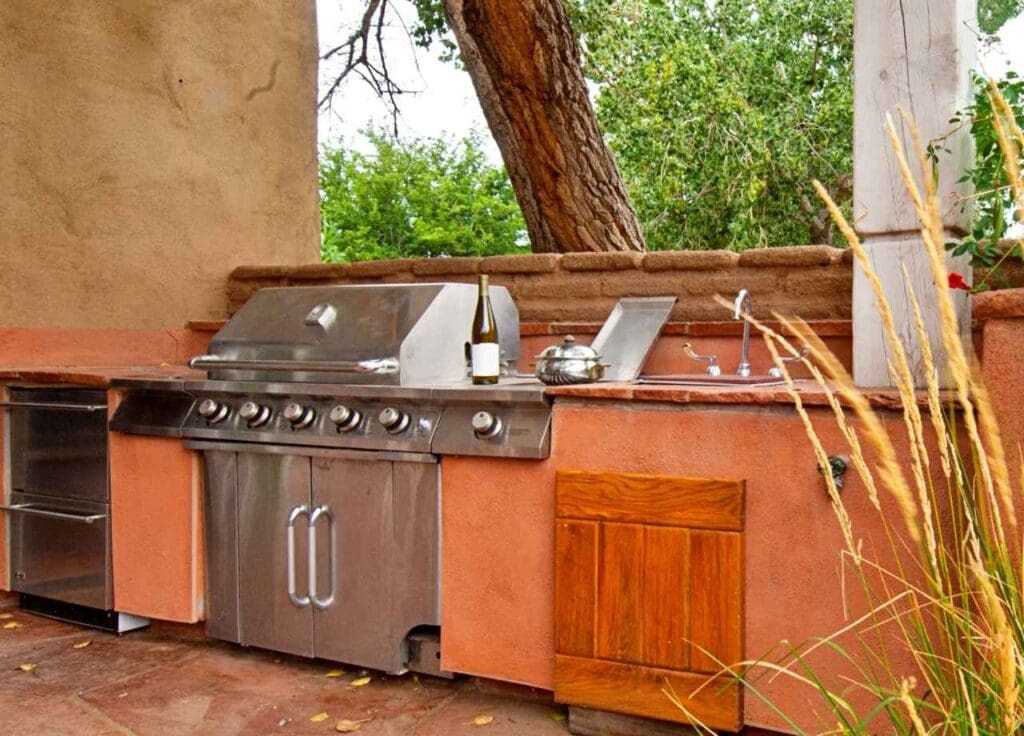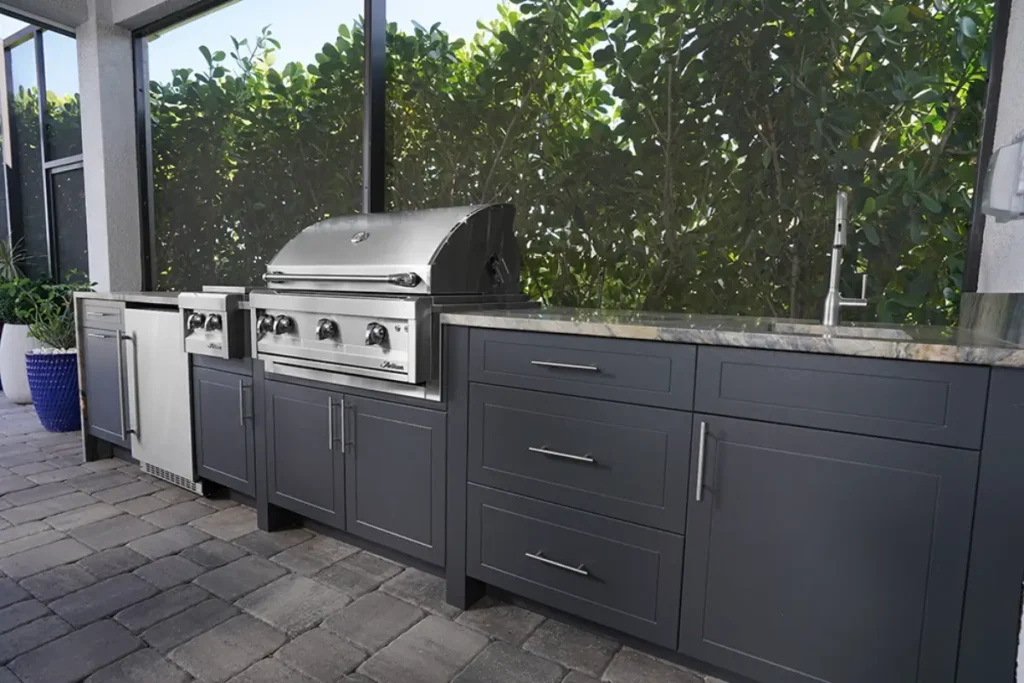
Stainless Steel vs Stone Outdoor Kitchens: What’s Best for Your Space?
Choosing the right materials for your outdoor kitchen isn’t just about looks. It’s about durability, maintenance, long-term value, and how the kitchen functions with your space. In Jacksonville’s humid, salt-rich air, not every material is built to last. That’s where the conversation around stainless steel and stone becomes more than just a style debate.
At Calico Outdoor, we work with homeowners who want their outdoor kitchens to go the distance. And while we design with aesthetics in mind, our focus stays rooted in performance and how each material handles Florida’s coastal climate.
Table of Contents
The Core Differences Between Stainless Steel and Stone
On the surface, stainless steel and stone offer two very different aesthetics. Stainless steel leans modern, sleek, and clean. Stone brings an earthy, traditional, and often rustic vibe. But once you move beyond appearances, the real contrast starts to take shape in how each material performs outdoors.
Stainless steel is non-porous, resists corrosion, and is engineered for high-use environments. It’s commonly used in commercial kitchens for a reason. Stone, on the other hand, is porous by nature. Whether you opt for natural stone or a concrete-based stone veneer, moisture becomes a factor you have to manage, especially during rainy seasons or periods of high humidity.
Each has strengths, but those strengths play out differently depending on how you plan to use your space.
Durability: Who Handles the Elements Better?
Jacksonville summers bring heat, salt air, and rain—a trifecta that can break down outdoor materials quickly if they aren’t built for it. Stainless steel stands out here. When properly treated with a powder-coated finish or marine-grade alloys like 304 or 316, it becomes nearly immune to rust and corrosion. It doesn’t fade, peel, or split. It shrugs off UV rays and salt air without breaking a sweat.
Stone may seem tougher on the surface, but appearances are deceiving. Natural stone, particularly porous types like limestone or travertine, can absorb water and crack when temperatures fluctuate. Stone veneer products can delaminate over time if the bonding isn’t done right. Sealing helps, but sealing is a maintenance task you have to stay on top of.
If you want low-maintenance longevity, stainless steel is the clear frontrunner. Stone can last, but it asks more from you in upkeep.
Aesthetics and Customization
Both materials offer design flexibility, but in different ways. Stainless steel gives a clean, modern look that pairs well with contemporary patios, pools, and structured garden layouts. Powder coating adds an entire color palette, from bold hues to textured finishes that mimic other materials like wood grain or matte stone.

Stone shines when you want a more natural or traditional look. It blends seamlessly with paver patios, pergolas, and earthy outdoor décor. It offers texture and visual depth, and no two installations look quite the same.
The challenge with stone is that it’s harder to adjust after installation. Want to change the layout or add a new feature? Stonework has to be reworked or partially torn down. With stainless steel modular cabinetry, adding a new fridge, sink, or storage component is a more straightforward task.
Maintenance and Cleaning
Stainless steel outdoor kitchens are as close to maintenance-free as you can get. A quick wipe-down with a microfiber cloth and some mild detergent keeps surfaces looking like new. Powder-coated finishes are even easier, resisting fingerprints and stains.
Stone is more demanding. It can stain from oils, sauces, and grease. It collects mildew and grime more easily, especially in shaded or humid areas. Regular power washing and sealing become part of the routine. And once stone stains or chips, it’s not always easy to repair.
For homeowners who entertain frequently or use their outdoor kitchen year-round, stainless steel makes everyday cleaning and upkeep much less of a chore.
Structural Considerations and Installation
Stainless steel cabinetry is lighter and easier to install than stone. It can be freestanding or built into a simple frame, making it a better fit for rooftops, decks, or any area where weight is a factor. Installation is fast, and most components are modular, allowing for flexibility if your layout needs to evolve.
Stone, whether natural or veneered over block, requires a solid foundation. The weight of stone limits where it can be installed, and it usually takes longer to construct. If you’re on a tight timeline or building in a tricky spot (like a second-story balcony or poolside platform), stone may introduce more headaches than it’s worth.
Cost Over Time
Initial costs for stainless steel and stone can be similar depending on the design, but the long-term costs tilt in favor of stainless steel. With fewer maintenance needs, better weather resistance, and easier upgrades, stainless steel kitchens tend to hold up better with fewer surprise expenses.
Stone kitchens, while beautiful, can lead to more costs down the road: re-sealing, repairs, or water damage mitigation. If you’re working with a contractor not familiar with outdoor kitchens, it’s easier for stone builds to go sideways during construction, especially in Florida’s rainy season.
Heat Resistance and Cooking Considerations
Both materials handle high heat well, but stainless steel has the edge when it comes to proximity to grills and cooktops. It won’t discolor or break down under direct heat. It also reflects heat away rather than absorbing it, keeping nearby cabinets and surfaces cooler.

Stone can absorb and retain heat, which isn’t always ideal when you’re standing over it in 90-degree weather. And if you’re installing appliances directly into a stone structure, the framing and spacing need to be exact, or you risk poor ventilation and long-term performance issues.
When Stone Makes Sense
Stone still has its place. If you’re building an outdoor space where aesthetics take priority over daily use—say, a showpiece patio that hosts occasional get-togethers—stone might be worth the extra maintenance. It adds texture, warmth, and a timeless look that stainless steel can’t replicate.
But it does best in drier climates or areas with seasonal use. In Jacksonville, where humidity and rain are year-round guests, stone is better suited for partial builds or as an accent material around a core stainless structure.
Final Thoughts
If your goal is to create a long-lasting, low-maintenance, weather-resistant outdoor kitchen that functions year-round in Jacksonville’s climate, stainless steel outperforms stone in most categories. From installation to cleaning to durability, it’s a practical choice that doesn’t sacrifice good looks.
Stone brings character, but it comes with demands—more maintenance, more careful installation, and a higher risk of wear in wet environments.
Either way, make sure your material choice aligns with how you’ll use your outdoor kitchen. If you’re building it to enjoy daily, not just admire from a distance, stainless steel is a smart, flexible foundation for outdoor living that lasts.
Want to see what stainless steel and stone look like side by side in a real backyard? Contact Calico Outdoor and schedule a consultation. We’ll walk you through both options and help you build something that fits your style, your space, and the way you live.
